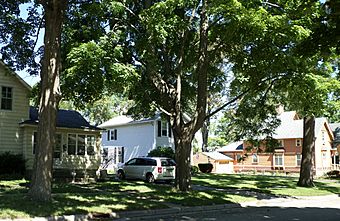Westside Neighborhood Historic District facts for kids
Quick facts for kids |
|
|
Westside Neighborhood Historic District
|
|
 |
|
| Location | Roughly bounded by W. Maple, W. Ash, Lansing and McRoberts Sts., Mason, Michigan |
|---|---|
| Area | 11 acres (4.5 ha) |
| Architectural style | Colonial Revival, Queen Anne |
| MPS | Mason Michigan Historic MRA |
| NRHP reference No. | 85001242 |
| Added to NRHP | June 6, 1985 |
The Westside Neighborhood Historic District is a special area in Mason, Michigan, filled with old homes. It's located along West Maple and West Ash Streets, near Sycamore Creek. This neighborhood is important because its history and unique buildings have been officially recognized. It was added to the National Register of Historic Places in 1985, which helps protect its unique character.
History of the Westside Neighborhood
This historic area is part of a larger plan called the Barnes and Price Addition, created in 1866. Building homes here started in the 1870s. Many of the houses you see today were built in the late 1800s.
The first people who lived in these homes were often business owners and professionals. For example, there were tinsmiths (people who worked with tin), an undertaker, a foundry owner (who ran a metal factory), a carpenter, and even a doctor. A retired city attorney also lived in this neighborhood.
Exploring the Westside Historic District
The Westside Neighborhood Historic District is shaped like a rectangle. It covers one block of West Maple Street and one block of West Ash Street. It also includes the city park, which runs along both sides of Sycamore Creek.
There are 47 main buildings in the district. Most of them are single-family homes made of wood. They were built in the late 1800s. These houses sit on large lots along streets lined with trees. They are also set back a bit from the road.
Many homes here show off popular styles from the past. You'll see Colonial Revival and Queen Anne designs. Some homes also have simpler, older styles like Greek Revival and Italianate.
The Mason City Park is a beautiful green space that has been used by the city's residents for a very long time. The district also has two interesting bridges. One is an old stone arch railroad bridge built in 1888 over Sycamore Creek. The other is a concrete arch bridge on Maple Street.
Notable Homes in the District
Here are some of the special houses you can find in the Westside Neighborhood Historic District:
- Harlow A. Beech House (452 West Maple): This two-story house was built in 1887 for Harlow A. Beech. He owned an iron foundry, which is a factory that makes metal products. The house has a unique roof shape and different types of wood siding.
- Augustus A. Howard House (451 West Ash Street): Built in 1878 or 1879, this two-story house belonged to Augustus A. Howard, who owned a local grocery store. Later, around 1900, Sidney and Anna Culver bought the house and added a two-story section to the back.
- Joseph P. Smith House (414 West Maple): This large, two-story Queen Anne style house was built in 1889. It was home to Joseph P. Smith, a tinsmith, and his wife Lillian. They lived there until 1922. The house has lots of fancy decorations, especially on its porch.
- James Fred and Lizzie Lewis House (427 West Maple): Built in 1890 for James and Lizzie Lewis, this house was later bought by John C. Fingerle in 1891. He was a partner in a hardware business. It's a charming two-story Queen Anne house with decorative fish-scale shingles on the gables (the triangular parts of the roof).
- James A. Sherwood House (404 West Maple): This house was built in 1893 for James A. Sherwood, who was a contractor and sold lumber. It's an L-shaped, two-story house with multiple gables. It features wood siding and fish-scale shingles.
- George W. Bristol House (439 West Ash Street): Constructed in 1912, this house belonged to George W. Bristol. He was an important community leader and came from one of the first families to settle in the area. It's a large, two-and-a-half-story Colonial Revival style house with a big gable dormer (a window structure that projects from a sloping roof) in the center.



